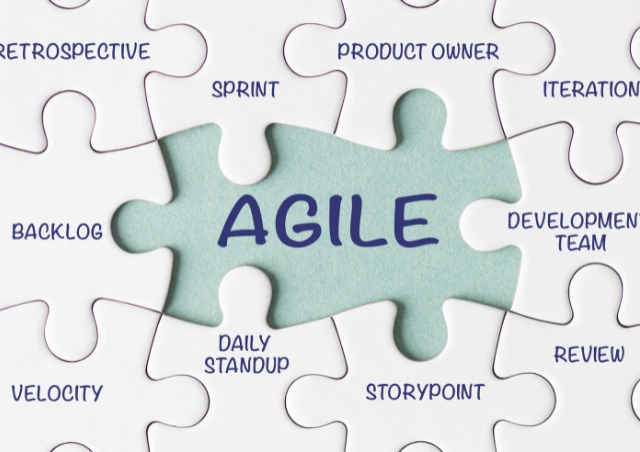In the previous blog posts, we discussed that many organisations focus on implementing Agile methodologies and tools when going through transformation journeys. Now that we have delved into the core values of Agile, it’s time to take the next step on our journey – uncovering the meaning of these methodologies and exploring the most popular ones.
What do Agile methodologies mean?
So far, we discussed in detail the four Agile Core values, which are the central of the Agile Manifesto. In summary, we concluded that they are interconnected and reinforce each other, valuing individuals, prioritising working solutions, collaborating closely with customers, and embracing change.
Agile methodologies are specific approaches and practices that put these core values into life. They suggest ways how the Agile Core values can be operationalised in the day-to-day work by introducing processes, practices, and roles. They are the means through which organisations can, for example, focus on collaboration among various stakeholders, embrace change and empower team members in decision-making. As the ultimate job of methodologies is to implement the Agile core values, they will only succeed if the mindset is aligned with them.
What are some of the Agile methodologies?
Some of the most popular Agile methodologies include:
| Name | Brief Overview | Some Practices, Principles & Roles |
|---|---|---|
| Scrum | Scrum sees its inception in IT but has since been adapted and applied across other domains. It is a prominent Agile methodology that focuses on change acceptance through iterative development, collaboration, and customer participation. Scaling Scrum to large organisations is challenging, thus the rise of Agile Frameworks which we shall examine later in this post. | Practices & Principles: Sprints, Daily Standup Meetings, Sprint Planning, Sprint Review, Sprint Retrospective. Roles: Scrum Master, Product Owner, and Development Team. |
| Kanban | Kanban, which originated in the manufacturing sector and is associated with the Toyota production system, mainly focuses on managing work as a flow. It provokes improvements by looking at reducing bottlenecks, allowing for continuous delivery and higher efficiencies. | Practices & Principles: Visualized Workflow, Work in Progress (WIP) Limits, Continuous Improvement. Roles: No specific roles. |
| Extreme Programming (XP) | Although, traditionally, Extreme Programming was used in IT, its practices have also been proven successful in other domains. This methodology emphasises collaboration, communication, and iterative development through a variety of practices that can be adjusted to the situation. | Practices & Principles: Pair Programming, Test-Driven Development (TDD), Continuous Integration, Small Releases. Roles: Programmer (or the person performing the task), Tester, Customer. |
| Feature-Driven Development (FDD) | FDD uses visuals and models as guidance to the development process. As the name suggests, FDD focuses on building features, thus increasing collaboration and customer involvement. Due to its model-driven approach, FDD is sometimes perceived as a complex way of working on small projects, demanding specialised expertise. | Practices & Principles: Develop an Overall Model, Build a Features List, Plan by Feature, Design by Feature, Build by Feature. Roles: Chief Architect, Chief Programmer, Domain Experts, and Team. |
| Crystal | Crystal recognises the value of having a flexible Agile methodology depending on the overall project context. As such, it offers different methodology variants grouped under the name “Crystal”. These variants defer depending on the project size, team experience, culture, and complexities. However, each variant focuses on people, collaboration, and adapting to changing requirements. | Practices & Principles: Varies based on the Crystal variant. Roles: Varies based on Crystal variant but typically includes: Team Members, Sponsor, and Users. |
| Adaptive Software Development (ASD) | ASD is designed to address project uncertainty through collaboration, communication, speculative design, prototyping, feedback loops, and continuous learning. This approach focuses on reducing the overall risks by identifying and addressing issues early. | Practices & Principles: Speculate, Collaborate, Learn, Adapt. Roles: Programmer (or the person performing the task), Coordinator, Coach, Customer, Tester |
A short word about another practice called Lean, which is not an Agile methodology per se but some literature, including the PRINCE2 Agile, associates it with Agile.
Lean, also linked with the Toyota production system, focuses on eliminating waste, amplifying learning, and delivering value faster. It is therefore not surprising that Lean is sometimes viewed as another Agile Methodology given how well these align with the Agile core values.
The use of Agile Frameworks.
A related concept to Agile Methodologies is Agile Frameworks. Agile Frameworks are structures and practices encompassing multiple Agile methodologies, offering organisations the flexibility to use different approaches based on their needs. Some Agile Frameworks include:
| Name | Brief Overview | Some Practices, Principles & Roles |
|---|---|---|
| Nexus | Nexus is built around Scrum and primarily focuses on scaling Scrum across multiple teams. This is done to ensure that a product created by several scrum teams is fully integrated, and that there is coordination and alignment between the teams. | Practices & Principles: Scaled Scrum, Scrum of Scrums, Cross-Team Coordination Roles: Nexus Integration Team, Scrum Masters, Product Owners, Development Teams. |
| Scaled Agile Framework (SAFe) | SAFe was developed to address the scalability issue of implementing Agile across large-scale organisations. Apart from using several Agile Methodologies including Scrum and Kanban, SAFe also focuses on Lean, introducing what is called the Lean-Agile mindset. | Practices & Principles: Program Increments, Value Streams, Agile Release Train, PI Planning. Roles: Agile Teams, Product Owners, Scrum Master/Team Coach, Release Train Engineer, Business Owners. |
| PRINCE2 AGILE | As the name suggests, PRINCE2 Agile is a hybrid framework that combines the concepts of the PRINCE2 project management practices with Agile. It aims to provide organisations with a means of delivering projects with a balanced combination of control and flexibility. | Practices & Principles: PRINCE2 and Agile Practices. Roles: Project Manager, Team Members, Product Owner, Scrum Master (when using Scrum). |
Having explored different Agile Methodologies and Frameworks, we need to remember that these are just tools, helping us transform and run organisations with an Agile mindset.
Ultimately, deciding which methodology and framework to use is up to you. There are no rules. As you navigate the diverse array of options, consider the organisation’s size and culture, the available skills, the team sizes, and project complexities amongst several factors.
By harnessing the true power of the Agile mindset supported with the proper Agile framework, you pave the wave for a successful transformation!
As the objective of this post is to offer newcomers in the field of Agile a foundational understanding, I have intentionally simplified certain aspects of the content. If you seek more comprehensive and precise information, please don’t hesitate to reach out.
I’m Jonathan Spiteri, and I bring a wealth of experience in innovation, strategy, agile methodologies, and project portfolio management. Throughout my career, I’ve had the privilege of working with diverse teams and organisations, helping them navigate the ever-evolving landscape of business and technology. I’ve also earned multiple prestigious certifications, such as Axelos Portfolio Director, SAFe® 6 Practice Consultant, Organisation Transformation, Project Management Professional (PMP), TOGAF 9.2, and Six Sigma Black Belt. These qualifications reflect my dedication to achieving excellence and my proficiency across various domains.


